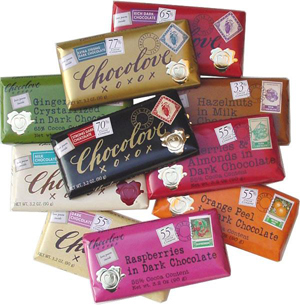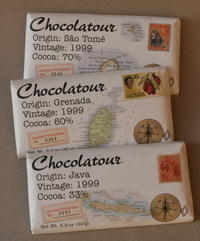 |


Send me a Chocolove, drop me a line, stating point of view! Here's ours: we love these creamy chocolate bars and hope you don't beat us to them as we scour stores for what's left of their sold-out 1999 vintage Chocolatour single origin bars.
|
Chocolove's Single Origin Bars: What's not to (Choco)love?
Depending on how sentimental or romantic you are, you might not love the idea of a chocolate bar that sends you hugs and kisses and includes a love poem by Shakespeare on the inside wrapper.
We actually like Chocolove's chocolate love letter marketing concept—but much more important, we love their delicious chocolate.
Even before the recent introduction of Chocolove’s single origin, vintage harvest cacao bean Chocolatour bars—which we will discuss shortly—we choco-loved their crunchy Fruit and Nut line. These bars are one of our favorite ways to enjoy orange |
peel, raspberries, or cherries and almonds, finely minced into 55% cacao dark chocolate bars; and that rara avis in cacao, crystallized ginger in 65% dark chocolate. There’s a hazelnut bar of 33% cacao milk chocolate to round out the Fruit and Nut line. Chocolove also makes pure bars in 33% milk, 55% and 65% Dark (semisweet), and 70% and 75% Strong Dark and Extra Strong Dark (bittersweet).¹ The beans are roasted in Belgium and made into blocks of chocolate to Chocolove’s specifications; the blocks are made into bars in the United States.
¹Mini-class on cacao (cocoa) percentages: When cacao nibs, the meat of the cacao bean, are ground, the mass is separated into cocoa butter and cocoa solids. The chocolate you eat contains both. Milk chocolate bars are generally made with 33% to 45% cacao. The category of “dark” chocolate comprises semi-sweet (55%-65%) and bittersweet (70% and greater). You can find bars in 85%, 99%, and 100%, the latter of which is pure cacao with no sugar added—but delicious for eating to those who like pure strong chocolate. White chocolate is not technically chocolate because it contains no cocoa solids: it is made from cocoa butter. And yes, cacao is the proper name of the bean and the tree it grows on. Cocoa was a misspelling on an English ship's manifest some 300 years ago and it stuck in our language.
Chocolatour Single Origin Bars
This year Chocolove introduced three single origin bean, vintage year bars: the beans are all from the 1999 harvest from from three specific growing regions: São Tomé in the Gulf of Guinea (off the west coast of Africa), Grenada in the Caribbean, and Java in the Pacific.
- These bars enable students of chocolate to see how different beans and different terroirs yield very different flavors in chocolate.
- We encourage you to taste the 70% São Tomé and 70% Grenada bars, e.g., along with Chocolove’s regular 70% Dark bar, a blend of beans from several different regions. If it is your first experience in comparative chocolate tasting, you will see the direct analogy to tasting and comparing wine.
We think of Chocolatour as “bridge” line of single origin bars. Let us explain this deep compliment to the specialness of these bars:
- The single origin bars from the great chocolate houses² tend to be cerebral chocolate. Bite into a São Tomé bar from Michel Cluizel or a Chuao bar from Amedei, for example, and you will spend five minutes analyzing the flavors—much in the way you analyze a complex glass of wine.
- You then discuss your findings with fellow connoisseurs to further identify every possible flavor and aroma component—not simply chocolate, cocoa, vanilla, caramel, or the simple flavors of a “regular” bar. You seek and find citrus, blueberry, molasses, olive, mushroom, strawberry, and other flavors most people would not associate with a chocolate bar—flavors that unschooled tasters seeking a “chocolate fix” might find alien, and not immediately enjoy. (See our chart on the flavors and aromas of chocolate.)
- You take detailed notes on these flavors, you compare this set of flavors to other producers’ single origin bars from the same regions, and to the same producer’s other single origin bars. You ponder and you taste some more. But you don’t just take a big bite and enjoy them in a state of simple chocolate happiness.
- In sum, many single origin bars, though acknowledged as the finest chocolate in the world, are products more for scholarly excitement among connoisseurs than for pure eating pleasure.
²We define a chocolate house as one that buys and roasts raw cacao beans and refines them into edible chocolate. Most make products for consumer and professional use; some make chocolate for commercial use only. THE NIBBLE™ covers only those houses that make consumers products. Names that may be familiar are Valrhona, Michel Cluizel, and Scharffen Berger.
We think Chocolove brilliantly bridges this gap between cerebral chocolate and universally appealing chocolate with the Chocolatour series of single origin bars. They are complex in flavor, interesting to the connoisseur, yet approachable and sensually enjoyable by anyone. Smooth and creamy in mouthfeel with a chewiness that we love (due to addition of extra cocoa butter), it was a happy day when these bars came into our lives. (Coincidentally, they arrived on Valentine's Day; but we won’t push that one).
Now for a tour of the three single origin bars from the 1999 Vintage. The beans were harvested, roasted and made into chocolate blocks in 1999. The chocolate was aged for five years; then melted, tempered, and formed into bars in December, 2004.
- São Tomé, 70%. An island 200 miles off the west coast of Africa is the birthplace of this bar, which is made from Amelondos, a variety of the Forastero bean that is known for strength over finesse. It offers robust cocoa flavor with just a touch of sweetness: this bar is for chocolate lovers who want a superior bittersweet experience. The bean yields tangy accents, a rich cocoa mid-palate and a very long aftertaste: the flavor lingers on the palate for five minutes or more after the chocolate is consumed.
- Grenada, 60%. An ocean away from São Tomé—in the Caribbean—and a world away in flavor, Grenada is a semisweet chocolate made in a sweet style. It could appeal to milk chocolate lovers who are accustomed to the higher sugar levels of milk, but want to try a the different flavor profile of dark, chocolate. The bean is Trinitario, a hybrid of the hardy Forastero and the delicate but flavorful Criollo. This bar is for dark chocolate lovers who enjoy sweetness in their bar and will appreciate the superior quality of both bean and fabrication.
- Java 33%. Yet another ocean away, this time in the South Seas, the island of Java produces a variety of Criollo bean unique to the island (and called Java whites). The bar is a sweet milk chocolate with interesting nuances of caramel, marshmallow, and banana. While most single origin 33% bars are a different style of milk than Americans are accustomed to—a less sweet, European style—this bar has a familiar level of sugar one would find in top quality American chocolate along with complex flavors to be found in no other.
Whether it’s the seratonin re-uptake inhibitors or simply the experience of the Chocolatour single origin bars (or the rest of this enjoyable line of fine chocolate bars)...no matter how bad a day you may have had...how inured you may be to little pillows of chocolate with tiny hearts engraved at their crests...one bite, like Cupid’s arrow, will make you fall in Chocolove.
—Karen Hochman
For more information on single origin chocolate bars, the flavor and aroma components of chocolate, chocolate terminology, and house styles, visit the Chocolate section of THE NIBBLE™ website, www.TheNibble.com.
CHOCOLOVE CHOCOLATE BARS
All bars are 3.2 ounces. Prices shown below are for mail orders from Chocolove. Prices are higher at online retailers, and prices at retail will vary. Retail prices for individual bars range from $1.79-$2.25 (higher for Chocolatour single origin bars).
Certified Kosher (dairy) by Tablet K.
- Pure Chocolate Bars, 12 bars (same flavor)
$20.00
- Fruit and Nut Bars, 12 bars (same flavor)
$20.00
- Gift Box of 9 Bars, $20.00
Chocolatour Single Origin Bars are sold out at
Chocolove but are available at Worldwide Chocolate for $3.50 bar as of the date of this writing.
UPDATE JUNE 2005: The 2004 Vintage Bars have just been released. Only 20,000 of each origin were made; and are available while supplies last from Chocolove.com, select gourmet retailers and online retailers.
Prices and product availability are subject to change. |
The producer has sold out the 1999 vintage, but you can still find it at fine specialty stores, and online at some
chocolate e-tailers. Stay tuned for the 2004 vintage.
|
For mail order from Chocolove, local retailers or online e-tailers, visit
chocolove.com.
FORWARD THIS NIBBLE to your chocolate-loving friends.
FOR ADDITIONAL INFORMATION, special offers, contests,
opinion surveys, THE NIBBLE back issues archive,
product search engine, links to our favorite food websites, and the ability to nominate YOUR
favorite nibbles, visit www.thenibble.com.
To change your subscriber preferences,
click here. To unsubscribe, send an e-mail to unsubscribe@thenibble.com.
To contact us with comments or suggestions, click here. If you received
this from a friend but would like to subscribe directly, go to www.thenibble.com.
© Copyright 2004-2025 Lifestyle Direct, Inc. All rights
reserved. All information contained herein is subject to change at any time
without notice. All details must be directly confirmed with manufacturers, service
establishments and other third parties. The material in this newsletter may not
be reproduced, distributed, transmitted, cached, or otherwise used, except with
the prior written permission of Lifestyle Direct, Inc.
|
 |
|
 |






